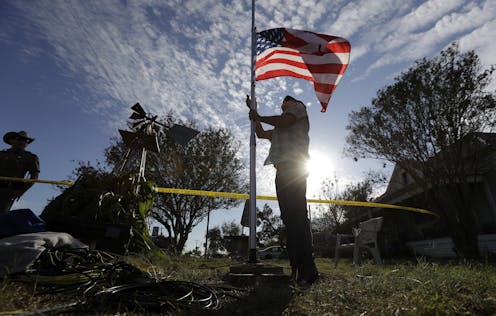Gun violence in the US kills more black people and urban dwellers
Data show the vast majority of people killed by gun violence are black, and live in urban areas.

On Nov. 5, just 35 days after the deadly Las Vegas shooting, a man walked into a church in a small Texas town and murdered 26 people with an assault rifle. The coverage dominated the news.
But the day before, even more people – 43 – were shot to death in cities and towns around the country. And nobody really seemed to notice.
Shootings kill more than 36,000 Americans each year. Every day, 90 deaths and 200 injuries are caused by gun violence. Unlike terrorist acts, the everyday gun violence that impacts our communities are accepted as a way of life.
Of all firearm homicides in the world, 82 percent occurs in the United States. An American is 25 times more likely to be fatally shot than a resident of other high-income nations.
As public health scholars who study firearm violence, we believe that our country is unique in its acceptance of gun violence. Although death by firearms in America is a public health crisis, it is a crisis that legislators accept as a societal norm. Some have suggested it is due to the fact that it is blacks and not whites who are the predominant victims, and our data support this striking disparity.
Urban and racial disparities
Within the United States, the odds of dying from firearm homicide are much higher for Americans who reside in cities. Twenty percent of all firearm homicides in the U.S. occur in the country’s 25 largest cities, even though they contain just over one-tenth of the U.S. population. Data from the Centers for Disease Control and Prevention show that of the 12,979 firearm homicides in 2015, 81 percent occurred in urban areas.
There is even more to the story: CDC data also show that within our nation’s cities, black Americans are, on average, eight times more likely to be killed by firearms than those who are white. The rate of death by gun homicide for black people exceeds those among whites in all 50 states, but there is tremendous variation in the magnitude of this disparity. In 2015, a black person living in Wisconsin was 26 times more likely to be fatally shot than a white person in that state. At the same time, a black person in Arizona was “only” 3.2 times more likely than a white person to be killed by a gun. The combination of being black and living in an urban area is even more deadly. In 2015, the black homicide rate for urban areas in Missouri was higher than the total death rate from any cause in New York State.
These differences across states occur primarily because the gap between levels of disadvantage among white and black Americans differ sharply by state. For example, Wisconsin – the state with the highest disparity between black and white firearm homicide rates – has the second highest gap of any state between black and white incarceration rates, and the second highest gap between black and white unemployment rates. Racial disparities in advantage translate into racial disparities in firearm violence victimization.
Americans are 128 times more likely to be killed in everyday gun violence than by any act of international terrorism. And a black person living in an urban area is almost 500 times more likely to be killed by everyday gun violence than by terrorism. From a public health perspective, efforts to combat firearm violence need to be every bit as strong as those to fight terrorism.
The first step in treating the epidemic of firearm violence is declaring that the everyday gun violence that is devastating the nation is unacceptable. Mass shootings and terrorist attacks should not be the only incidents of violence that awaken Americans to the threats to our freedom and spur politicians to action.
Michael Siegel receives funding from the Robert Wood Johnson Foundation Evidence for Action program to develop a database of state firearm laws and examine the impact of these laws on firearm violence.
Anita Knopov and Molly Pahn do not work for, consult, own shares in or receive funding from any company or organization that would benefit from this article, and has disclosed no relevant affiliations beyond their academic appointment.
Read These Next
Epstein’s victims deserve more attention than his ‘client list’
Powerful men connected to Jeffrey Epstein are named, dissected and speculated about. The survivors,…
The ‘one chatbot per child’ model for AI in classrooms conflicts with what research shows: Learning
AI tutors are often held up as an ideal, but prioritizing individualized teaching can detract from the…
Christmas trees are more expensive than ever in Colorado — what gives?
Most Christmas trees are imported from other states, which drives up costs.






